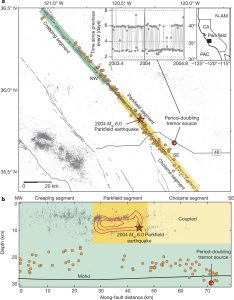
Scientists from Nanyang Technological University (NTU Singapore) at its Earth Observatory of Singapore (EOS) have discovered a way to forecast earthquakes based on slow fault movements caused by moving sub layers of the earth.
Scientists believe that larger earthquakes are unlikely to occur following tremors or earthquakes below a Richter scale of two that are caused by small vibrations or slow fault movements such as those observed in the area of Parkfield along the San Andreas fault in California, USA.
However, the NTU team found that not only do these vibrations potentially point to an impending earthquake, they also discovered a discernible pattern to them.
“This discovery defied our understanding of how faults accumulate and release stress over time. These vibration patterns are caused by alternating slow and fast ruptures occurring on the same patch of a fault,” said Asst Prof Sylvain Barbot, from NTU’s Asian School of the Environment and an earth scientist at EOS.
“If only slow movements are detected, it does not mean that a large earthquake cannot happen there. On the contrary, the same area of the fault can rupture in a catastrophic earthquake,” he warned.
The study which has major significance on the prediction of earthquakes was led by Asst Prof Barbot’s PhD student, Miss Deepa Mele Veedu. It was published in Nature, one of the most prestigious scientific journals in the world.
Seismic hazards in the Southeast Asia region will probably come from an impending large earthquake in the Mentawai seismic gap in Sumatra, Indonesia – a current area of active monitoring and investigation.
EOS scientists have earlier pointed out a large earthquake may occur any time in this area southwest of Padang – the only place along a large fault where a big earthquake has not occurred in the past two centuries. The team’s latest findings could potentially be applied in the seismic monitoring of the area to help better forecast large earthquakes in the region.
EOS conducts fundamental research on earthquakes, volcanic eruptions, tsunamis and climate change in and around Southeast Asia, towards safer and more sustainable societies.
Reference:
Deepa Mele Veedu et al. The Parkfield tremors reveal slow and fast ruptures on the same asperity, Nature (2016). DOI: 10.1038/nature17190
Note: The above post is reprinted from materials provided by Nanyang Technological University.










